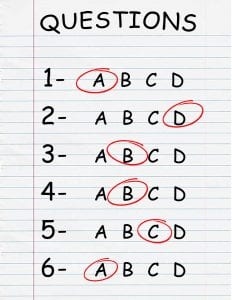
PoseMuse / Pixabay
Standardised testing has been present in Australia for almost two centuries. From parochial schools and their itinerant school inspectors; external examination boards and modern day NAPLAN; testing was designed to determine the quality of teaching and learning (Munro, 2017). This trend has lead to schools and teachers being held accountable for what students learn and achieve within the classroom, often to the detriment of learning. Often this scenario is described as high stakes, as test scores often correlate to level of status for student, teacher and school. Unfortunately, this accountability has inadvertently forced many teachers and schools to ‘teach to the test’ to bolster up their average scores. Teaching to the test as Popham (2001) points out is when teachers use learning activities that mimic the test conditions in that the cognitive demand is unchanged between the learning activity and the test.
A curriculum based on content is easier to teach and to test. Facts and figures are straightforward to assess compared to creativity and critical thinking which require understanding of nuances and emotional intelligence. This is especially true for automated tests in which answers are displayed in a multiple choice format. But are standardised test truly identifying if learning is actually occurring?
Education is changing and it is inevitable in this information age that fundamental basis of teaching and learning practices is to prepare students for the future. This preparation should include the opportunity to generate ideas, build creativity and encourage critical thinking as a process in order to create either a product or an idea (Markham, 2013). Markham (2013) even goes further to suggest that skills based assessments will eventually overtake content as markers of achievement.
Skills that are easily acquired, explained, evaluated and estimated are known as hard skills. These skills can be quantified and scaled against other people’s results. As this competence can be taught in stages, it can also be assessed with ease. Soft skills though are harder to teach as it requires more than just rote learning (Doyle, 2019). It requires a student to actively engage with the information and using their own cognition, construct this new information into their knowledge bank in order to create something from it. In this process of learning, students assemble their own learning content and develop a mastery of skills. Constructivist pedagogy is based upon the theory that people build or construct their own understanding of their world based upon what they already know and experience and what they discover in their learning (McLeod, 2018). Constructivism is the foundation of inquiry learning.
Inquiry learning as defined by LEQ (n.d.) is a constructivist approach in which the goal of learning is that students construct their own meaning from the task. As the learning is student centred, it requires the teacher to set the parameters and guide the students through the process as their motivation is intrinsic. The Melbourne Declaration of 2008 clearly describes the goals of education as enabling young Australians be successful in their learning, confident and creative in their endeavours and active and informed citizens (MCEETYA, 2008). Therefore, this form of learning has been included into the Australian national curriculum but only recently aligned with subject areas (Lupton, 2014). Whilst the research shows the widespread benefits to inquiry learning in schools there are a several barriers into implementing this process across the country.
The main issue with the implementation of inquiry learning is that it requires the teacher to hand over control of the learning to the student. The power of a content based curriculum lies within a teacher, and it’s entrenched traditions of ‘chalk & talk’ and ability to control learning outcomes within a prescribed time frame. It requires the teacher to understand that each student will maximise their learning if it is their individual third space and that collaboration is essential. Another facet of this disinclination in implementing inquiry learning is that teachers can be confused as to what aspects of the content needs to be taught explicitly and what strands need to be discovered. This is a fine art as Markham (2013) points out. In some circumstances, content is best taught explicitly before and or during an inquiry project. In other times, it can be taught at at the end of a unit as a ‘mop up lesson’ to address any learning outcomes that were accidentally missed. In some cases the skills need to also be taught such as the ability to question prior to commencing a task. This shift of educational thinking is more psychological rather than logistical.
Inquiry learning requires teachers to work along with their colleagues and para-professionals. Once again, it is a psychological shift in thinking that forces a teacher to realise that they are not the only font of all information but rather it is the collaboration of minds that build the best teaching and learning experiences for students. Classroom teachers who practice inquiry learning in its entirety need to be open to collaborating with their teacher librarian and other teachers. They need to create a safe learning space for their students to engage with other members of staff and not feel like its a personal rebuke. This can be difficult for many practitioners who through their teaching years have isolated themselves within their departmental and or classroom silos.
Inquiry learning requires redefining success within teaching and learning as measures of success cannot be simplified to a percentage or a score, but rather a demonstrated ability on a rubric (Markham, 2013). A performance rubric that identifies a students level of expertise in an individual strand. As the current standardised testing is aimed at an individual’s ability to address content, it needs to evolve to identify student’s cognitive ability along a continuum of growth and not restricted to age levels like the current system of NAPLAN.
References:
Doyle, A., (2019) The hard skills employers seek. The Balance Careers. Retrieved from https://www.thebalancecareers.com/what-are-hard-skills-2060829
The Educator (2018) Inquiry based learning: what the research says. Retrieved from https://www.theeducatoronline.com/au/news/inquirybased-learning-what-the-research-says/255693
Lupton, M., (2014) Inquiry skills in the Australian Curriculum v6: a bird’s eye view. Access November 2014. http://eprints.qut.edu.au/78451/1/Lupton_ACCESS_Nov_2014_2pg.pdf
Lutheran Education Queensland (n.d.) Approaches to learning. Inquiry based learning. Retrieved from https://www.australiancurriculum.edu.au/media/1360/lutheran-education-queensland-inquiry-based-learning.pdf
MCEETYA (20019) MCEETYA four-year plan 2009 – 2012. Retrieved from http://scseec.edu.au/site/DefaultSite/filesystem/documents/Reports%20and%20publications/Publications/National%20goals%20for%20schooling/MCEETYA_Four_Year_Plan_(2009-2012).pdf
McLeod, S., (2018) Piaget’s theory of cognitive development. Simply Psychology. Retrieved from https://www.simplypsychology.org/piaget.html
Markham, T., (2013) Inquiry learning vs. standardised content: Can they coexist? KQED. Retrieved from https://www.kqed.org/mindshift/28820/inquiry-learning-vs-standardized-content-can-they-coexist
Munro, J., (2017) Support for standardised tests boils down to beliefs about who benefits from it. Retrieved from https://theconversation.com/support-for-standardised-tests-boils-down-to-beliefs-about-who-benefits-from-it-86541
Popham, W., (2001) Teaching to the test. Educational leadership. 58:6. Retrieved from http://www.ascd.org/publications/educational-leadership/mar01/vol58/num06/Teaching-to-the-Test%C2%A2.aspx

